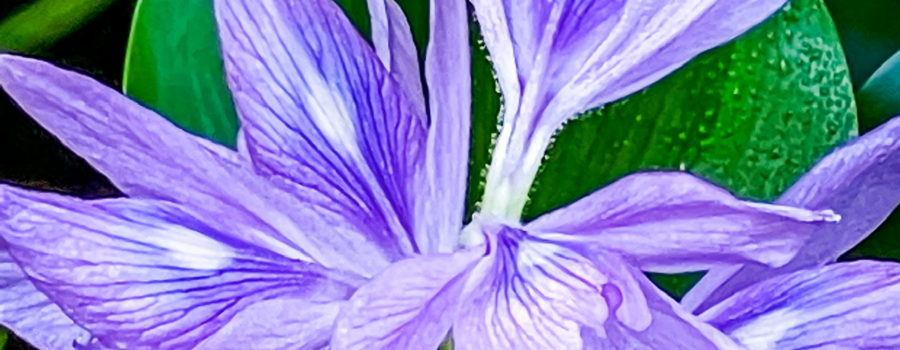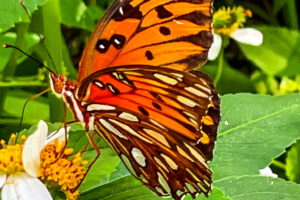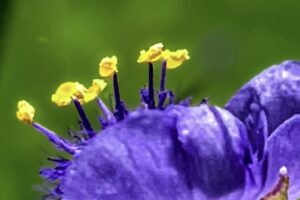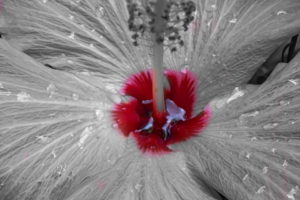Advantages and Disadvantages of the Beautiful Water Hyacinth

Last month I took my Mom’s dog for a walk while I was visiting her and she was otherwise occupied. She lives about an hour south of me, and in a much moister habitat, so I was sure that while walking we’d find some interesting things to photograph. And I wasn’t disappointed. I’ve already written about the Ohio spiderwort or as I know it, bluejacket. But that was far from the only plant that I found on our walk. One of the plants that I saw growing in most of the drainage ditches that run along many of the roads down there was an old friend. And nemesis. That plant is water hyacinth (Eichhornia crassipes). It used to (and I’m sure still does) grow in places in the river that ran through the area when I worked in the state wildlife park in Homosassa Springs. It’s a beautiful plant that produces very showy lavender flowers in spikes. But it grows like crazy, so several times each summer we had to go into those areas and thin it out. And let me tell you, a plant that has such a high water content is very heavy. It was always a grueling task in the 90 plus degree heat. Ugh!

Water hyacinth is actually native to South America, and more specifically, the Amazon basin. In it’s native environment there are several parasites, fungi, and insects that keep the rapidly growing plant in check. But because of it’s great beauty and striking flowers people have introduced it to nonnative habitats all over the tropical and subtropical world. Without it’s natural controls, the plant spreads rapidly and easily invades surrounding waterways. It reproduces both by seed production and by spreading outwardly from stem-like parts of the plant called stolons.. This rapid growth rate enables water hyacinth to out compete local native plants and take over their habitats. Those native plants are often eaten by and provide shelter to local wildlife, so their loss can be harmful to those wildlife populations, too. Water hyacinth tends to form large, dense mats of vegetation on top of the water, and have dense root systems under the water. The mats on top of the water can actually block out the sunlight getting to the water and further damage the habitat and severely lowering the water’s oxygen content. Fish, tadpoles, and other water breathing organisms may actually suffocate. The dying vegetation and wildlife decay in the water, causing even more damage.

So if water hyacinth is so awful, what is it good for? Well, of course, there are the gorgeous flowers and leaves that make it highly desirable as an ornamental for ponds and water features. The plant is also well known for it’s ability to remove heavy metals and toxins from the water where it lives. It easy to see what a great benefit this can be to the environment and some scientists have experimented with using water hyacinth to clean up factory watersheds, chemical spills, and sewage retention ponds. This remarkable ability means that in the United States and some other parts of the world, water hyacinth is considered a poisonous plant. But when not grown in polluted waters, water hyacinth is in fact quite edible. Another use for this highly prolific plant is as a feed for grazing animals and other livestock. Florida manatees will feed on it, but it doesn’t seem to be their food item of choice. People can use water hyacinth in salads, or as a table vegetable. In some parts of the world, dried water hyacinth is used as material to produce paper and to make fibers for weaving footwear, bags, baskets, etc. Water hyacinth has even been experimentally used to produce biofuel. And for those folks that like to fish, the root systems make an ideal place for bass to shelter!

As you can see, there are definitely pluses and minuses to an invasive species like water hyacinth. In this particular case, the invasive nature of the plant and the severe damage it can cause has made it illegal to have, propagate, or sell without a permit in some states, including Florida. Even with these regulations in place, however, the plant is far from uncommon down here. And I do have to say that whenever I see it growing I have to admire it’s beauty, but I also remember those backbreaking afternoons in the broiling heat trying to keep it under control in the park. Even my memories of this plant are a mixed blessing!

If you like beautiful nature photography and artwork accompanied by interesting, thought provoking content, then you’ll love this blog. Subscribe and find out what you’ve been missing!





Recent Comments